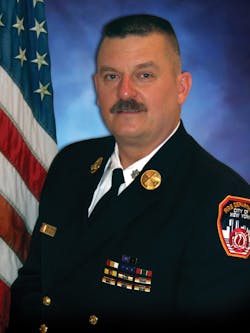An engine and truck arrive at the scene of a fire in a private dwelling. As they arrive, the dispatcher informs them that there are reports of people still in the house. The officer of the truck climbs out of the cab and looks back at the firefighters, also dismounting the rig and says nothing. He turns and quickly heads toward the front door. The engine officer is also getting out of the cab and moving toward the same location, the front door. The engine firefighters are right behind the officer with a 1¾-inch hoseline. Neither of these officers has said a word to any of the firefighters yet, they are all heading off in different directions with tools in hand.
The firefighters in these units already know what their fire scene assignments are, and they get off the rig knowing what tools to take, where to operate and who if anyone will be with them. These firefighters could be from a career, on-call or volunteer department. Let’s take a look at the several different ways that firefighters can be given tactical assignments.
Selection process
Some career departments have simple and generalized assignments. Remember that engine and truck duties are quite different, so making truck assignments may be more challenging. For an engine, obviously we need a nozzle team. That could be a nozzle firefighter and a back-up firefighter. Of course, someone is sitting in the front right seat, so we have an officer as well. Even with just 3 or 4 people on an engine we will have an engineer or driver, an officer and a firefighter. The officer and firefighter make up the nozzle team and the engineer is outside at the pump. If a second firefighter is on board, the officer can supervise the two firefighters who will be the nozzle team. This scenario would work well for volunteer or career units with that staffing.
Let’s take a look at the truck assignments now. As the ladder company arrives, the officer gets that last-minute info about people trapped inside. Truck company assignments in large departments are often task specific. For example, a firefighter may be assigned to go to the roof. Another might be assigned to perform forcible entry and so on. These assignments would be given at the start of a work shift and conducted on every run. For a volunteer department, a similar set of assignments can be given, but it would be handled in a different way, such as each of the seats in the cab would be identified with the tactical assignment that the firefighter riding there will have at the fire scene. Simply put, if you are sitting in the forcible entry seat, you carry the irons and go inside with the officer.
What if a career or volunteer department is faced with short staffing? What if the truck has just 4-person staffing? An officer and driver and two firefighters will now have to handle the initial workload. In situations such as this, some departments will assign each of the firefighters a general tactical assignment. One might be “interior” and the other would be “exterior.” With all the work that needs to be done, the first officer would assign the interior firefighter to carry the irons and work with him, and the exterior firefighter could be given an exterior ventilation assignment. All the assignments cannot be covered by just 3 people. The second truck, or whatever unit is assigned, will pick up the roof or laddering the exterior assignments.
Choose carefully
As we all know not every firefighter has the same level of experience or tactical skills. For this reason, fire scene assignments, whether given at the start of a shift, or whether the officer assigns riding positions as the unit is preparing to respond, or at the scene as the firefighters dismount the apparatus, need to be handed out carefully. The management, supervision and assignment of the tactical assignments by company officers may be one of the most important responsibilities that they have. Which firefighter is selected, and the skills and abilities of that firefighter, may very well have a direct impact on the ability of the unit to achieve their tactical goals. Add to this the on-scene conditions and reports concerning the location of the fire, the condition of the building, the presence of trapped civilians and many more vital variables that can and should have an impact on the tactical assignments the officer is required to make.
The work that fire companies perform at fires and emergencies is dangerous, fast-moving and often performed with little or no advanced information. Making the best tactical assignments increases the chances of positive outcomes, successful operations and lives saved.
About the Author
John J. Salka Jr.
Battalion Chief
JOHN J. SALKA JR., who is a Firehouse contributing editor, retired as a battalion chief with FDNY, serving as commander of the 18th battalion in the Bronx. Salka has instructed at several FDNY training programs, including the department’s Probationary Firefighters School, Captains Management Program and Battalion Chiefs Command Course. He conducts training programs at national and local conferences and has been recognized for his firefighter survival course, “Get Out Alive.” Salka co-authored the FDNY Engine Company Operations manual and wrote the book "First In, Last Out–Leadership Lessons From the New York Fire Department." He also operates Fire Command Training, which is a New York-based fire service training and consulting firm.

